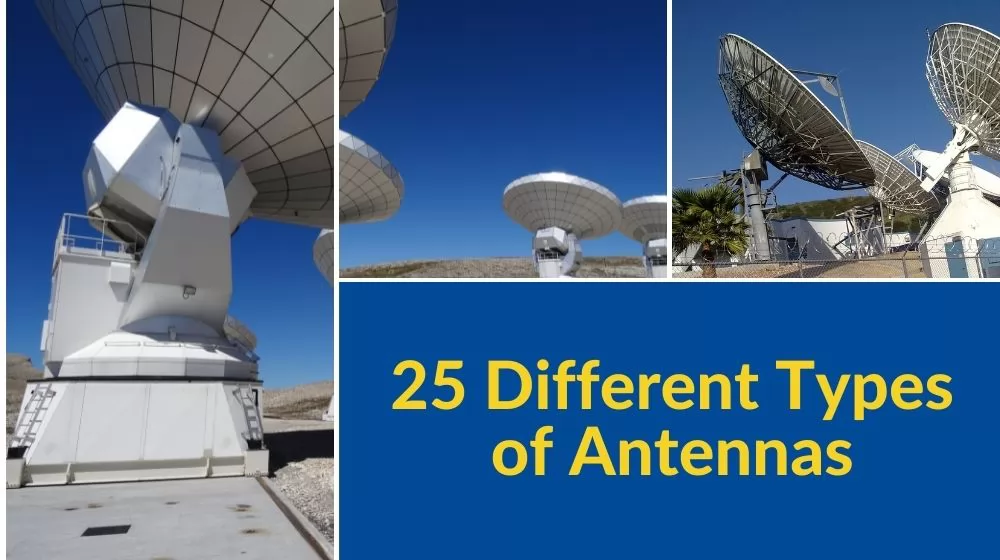
There are many types of antennas, so do you know the types of these antennas? As a professional satellite antenna manufacturer, Newstar will take you to learn about these 25 different types of antennas today.
1. Long wave antenna, medium wave antenna
It is a collective term for transmitting antennas or receiving antennas that work in the long-wave and medium-wave bands. Long and medium waves propagate by ground and sky waves, while sky waves are continuously reflected between the ionosphere and the earth. According to this propagation characteristic, long and medium wave antennas should be able to generate vertically polarized waves. Among the long and medium wave antennas, vertical, inverted L, T, and umbrella vertical ground antennas are widely used. Long and medium wave antennas should have a good ground net. Long and medium wave antennas have many technical problems, such as small effective height, small radiation resistance, low efficiency, narrow passband, and small directivity coefficient. In order to solve these problems, the antenna structure is often very complicated and very large.
2. Shortwave antenna
Transmitting or receiving antennas that work in the short-wave band are collectively referred to as short-wave antennas. The short wave is mainly propagated by the sky wave reflected by the ionosphere, and it is one of the important means of modern long-distance radio communication. There are many forms of shortwave antennas, among which symmetrical antennas, in-phase horizontal antennas, double-wave antennas, angular antennas, V-shaped antennas, diamond antennas, fishbone antennas, etc. are most used. Compared with long-wave antennas, short-wave antennas have a large effective height, large radiation resistance, high efficiency, good directivity, high gain, and bandwidth.
3. Ultrashort wave antenna
The transmitting and receiving antennas that work in the ultrashort wave band are called ultrashort wave antennas. Ultrashort waves mainly rely on space waves to propagate. There are many forms of this kind of antenna, among which the most used are Yagi antennas, disc-cone antennas, bi-cone antennas, and "batwing" TV transmitting antennas.
4. Microwave antenna
Transmitting or receiving antennas that work in meter wave, decimeter wave, centimeter wave, millimeter wave and other wave bands are collectively referred to as microwave antennas. Microwaves mainly rely on space waves to propagate. In order to increase the communication distance, the antenna is set up relatively high. Among microwave antennas, parabolic antennas, horn parabolic antennas, horn antennas, lens antennas, slot antennas, dielectric antennas, periscope antennas, etc. are widely used.
5. Directional antenna
A directional antenna refers to an antenna that emits and receives electromagnetic waves in one or several specific directions is particularly strong, while transmitting and receiving electromagnetic waves in other directions is zero or very small. The purpose of using a directional transmitting antenna is to increase the effective utilization of radiated power and increase confidentiality; the main purpose of using a directional receiving antenna is to increase the anti-interference ability.
6. Non-directional antenna
Antennas that radiate or receive electromagnetic waves uniformly in all directions are called non-directional antennas, such as whip antennas for small communication devices.
7. Broadband antenna
An antenna whose directivity, impedance, and polarization characteristics remain almost unchanged over a wide band is called a broadband antenna. Early broadband antennas include diamond antennas, V-shaped antennas, wave-doubling antennas, disc-cone antennas, etc., and new broadband antennas include log-period antennas.
8. Tuning the antenna
An antenna with a predetermined directivity only in a very narrow frequency band is called a tuned antenna or a tuned directional antenna. Generally, a tuned antenna only maintains its directivity in the 5% band around its tuning frequency, while at other frequencies, the directivity changes very drastically, so that the communication is destroyed. Tuned antennas are not suitable for shortwave communications with variable frequencies. In-phase horizontal antennas, folded antennas, zigzag antennas, etc. are all tuned antennas.
9. Vertical antenna
A vertical antenna refers to an antenna placed perpendicular to the ground. It has two forms, symmetrical and asymmetrical, and the latter is widely used. Symmetrical vertical antennas are often center-fed. The asymmetric vertical antenna is fed between the bottom of the antenna and the ground, and its maximum radiation direction is concentrated in the ground direction when the height is less than 1/2 wavelength, so it is suitable for broadcasting. Asymmetrical vertical antennas are also called vertical grounded antennas.
10. Inverted L antenna
An antenna formed by connecting a vertical down conductor to one end of a single horizontal wire. Because its shape resembles the reverse of the English letter L, it is called an inverted L-shaped antenna. The word Γ in the Russian alphabet is exactly the reverse of the English letter L. Therefore, it is more convenient to call a Γ-type antenna. It is a form of vertically grounded antenna. In order to improve the efficiency of the antenna, its horizontal part can be composed of several wires arranged on the same horizontal plane. The radiation generated by this part is negligible, while the vertical part generates radiation. Inverted L antennas are generally used for long-wave communications. Its advantages are simple structure and convenient erection; its disadvantages are large floor area and poor durability.
11.T-shaped antenna
In the center of the horizontal wire, connect a vertical down wire, the shape is like the English letter T, so it is called a T-shaped antenna. It is the most common type of vertically grounded antenna. The horizontal part of the radiation is negligible, and the vertical part produces radiation. In order to improve efficiency, the horizontal part can also be composed of multiple wires. The characteristics of the T-shaped antenna are the same as the inverted L-shaped antenna. It is generally used for long wave and medium wave communications.
12. Umbrella antenna
On the top of a single vertical wire, lead several inclined conductors in various directions. The antenna formed in this way is shaped like an open umbrella, so it is called an umbrella antenna. It is also a form of vertically grounded antenna. Its characteristics and uses are the same as inverted L-shaped and T-shaped antennas.
13. Whip antenna
The whip antenna is a flexible vertical rod antenna whose length is generally 1/4 or 1/2 wavelength. Most whip antennas do not use ground wires but use ground nets. Small whip antennas often use the metal shell of a small radio as a ground net. Sometimes in order to increase the effective height of the whip antenna, some small radial blades can be added to the top of the whip antenna or an inductance can be added to the middle end of the whip antenna. The whip antenna can be used for small communication devices, walkie talkies, car radios, etc.
14. Symmetrical antenna
The two parts of the same length and the center is disconnected and connected to feed the wire, which can be used as transmitting and receiving antennas. The antenna formed in this way is called a symmetrical antenna. Because antennas are sometimes called vibrators, symmetrical antennas are also called symmetrical vibrators, or dipole antennas. A symmetrical oscillator with a total length of half a wavelength is called a half-wave oscillator, also called a half-wave dipole antenna. It is the most basic unit antenna and is also the most widely used. Many complex antennas are composed of it. The half-wave vibrator has simple structure and convenient power feeding, and is widely used in short-distance communication.
15. Cage antenna
It is a wide-band weakly directional antenna. It is formed by replacing a single-wire radiator in a symmetrical antenna with a hollow cylinder surrounded by several wires. Because the radiator is a cage, it is called a cage antenna. The cage antenna has a wide working band and is easy to tune. It is suitable for short-distance trunk communication.
16.Angular antenna
It belongs to a category of symmetrical antennas, but its two arms are not arranged in a straight line, forming an angle of 90° or 120°, so it is called an angular antenna. This kind of antenna is generally horizontal, and its directivity is not significant. In order to obtain wide-band characteristics, the double arms of the angular antenna can also adopt a cage structure, which is called an angular cage antenna.
17. Folding antenna
A symmetrical antenna that bends the vibrator into parallel is called a folded antenna. There are several forms of double-line folded antenna, three-line folded antenna and multi-line folded antenna. When bending, the currents at the corresponding points on each line should be in phase. From a distance, the entire antenna looks like a symmetrical antenna. However, compared with a symmetrical antenna, the folded antenna has enhanced radiation. The input impedance increases to facilitate coupling with the feeder. The folded antenna is a tuned antenna with a narrow working frequency. It is widely used in shortwave and ultrashort wave bands.
18.V-shaped antenna
It is composed of two wires at an angle to each other, shaped like an antenna of the English letter V. Its terminal can be open circuit or connected to a resistor, the size of which is equal to the characteristic impedance of the antenna. The V-shaped antenna is unidirectional, and the maximum emission direction is in the vertical plane of the diagonal direction. Its disadvantages are low efficiency and large footprint.
19. Diamond antenna
It is a broadband antenna. It consists of a horizontal rhombus suspended on four pillars. One acute angle of the rhombus is connected to the feeder, and the other acute angle is connected to a terminal resistance equal to the characteristic impedance of the rhombus antenna. It is unidirectional in the vertical plane pointing to the direction of the terminal resistance.
The advantages of the diamond antenna are high gain, strong directivity, wide use band, easy installation and maintenance; the disadvantage is that it covers a large area. After the rhombus antenna is deformed, there are three forms of double rhombus antenna, feedback rhombus antenna and folded rhombus antenna. Diamond antennas are generally used for large and medium-sized shortwave receiving stations.
20. Disk cone antenna
It is an ultrashort wave antenna. On the top is a disk (ie, radiator), fed by the core wire of the coaxial line, and on the bottom is a cone, connected to the outer conductor of the coaxial line. The function of the cone is similar to that of an infinite ground. Changing the inclination angle of the cone can change the maximum radiation direction of the antenna. It has an extremely wide frequency band.
21. Fishbone antenna
Fishbone antenna, also called side-fire antenna, is a special short-wave receiving antenna. It consists of connecting a symmetrical oscillator at a certain distance on two assembly lines, and these symmetrical oscillators are all connected to the assembly line through a small capacitor. At the end of the assembly line, that is, the end facing the communication direction, a resistor equal to the characteristic impedance of the assembly line is connected, and the other end is connected to the receiver through the feeder. Compared with the diamond antenna, the fishbone antenna has the advantages of small side lobes (that is, strong reception in the direction of the main lobe and weak reception in other directions), small interaction between the antennas, and small footprint; the disadvantage is efficiency Low, installation and use are more complicated.
22. Yagi antenna
Also called the steering antenna. It consists of several metal rods, one of which is a radiator, the longer one behind the radiator is a reflector, and the shorter ones in the front are directors. The radiator usually uses a folded half-wave oscillator. The maximum radiation direction of the antenna is the same as the direction of the director. The advantages of the Yagi antenna are simple structure, light weight and sturdiness, and convenient power feeding; the disadvantages are narrow frequency band and poor anti-interference. It is used in ultrashort wave communication and radar.
23. Sector antenna
It has two forms: metal plate type and metal wire type. Among them, it is a fan-shaped metal plate type and a fan-shaped metal wire type. This kind of antenna enlarges the cross-sectional area of the antenna, so the antenna frequency band is widened. The wire sector antenna can use three, four or five metal wires. Sector antennas are used for ultrashort wave reception.
24. Biconical antenna
The biconical antenna is composed of two cones with opposite cone tips, and power is fed at the cone tips. The cone can be made of metal surface, metal wire or metal mesh. Just like a cage antenna, as the cross-sectional area of the antenna increases, the antenna frequency band also widens. Biconical antennas are mainly used for ultrashort wave reception.
25. Parabolic antenna
The parabolic antenna is a directional microwave antenna, which is composed of a parabolic reflector and a radiator. The radiator is installed on the focal point or focal axis of the parabolic reflector. The electromagnetic wave emitted by the radiator is reflected by the parabola to form a very directional beam.
The parabolic reflector is made of metal with good conductivity. There are four main methods: rotating paraboloid, cylindrical paraboloid, cut-off rotating paraboloid and elliptical edge paraboloid. The most commonly used are rotating paraboloid and cylindrical paraboloid. The radiator generally uses half-wave oscillators, open waveguides, slotted waveguides, etc.
The parabolic antenna has the advantages of simple structure, strong directivity, and wide working frequency band. The disadvantages are: because the radiator is located in the electric field of the parabolic reflector, the reflector has a large reaction effect on the radiator, and it is difficult for the antenna and the feeder to match well; the back radiation is large; the degree of protection is poor; and the manufacturing accuracy is high. This antenna is widely used in microwave relay communication, tropospheric scatter communication, radar and television.
The above is an introduction to the 25 different types of antennas that we have brought to you. If you have more questions or are interested in products, visit our website or contact us.
As the most professional manufacturer of Chinese satellite antennas, Shaanxi Newstar was established in 2008. Provide microwave and wireless convergent communication network solutions including satellite communication antenna research and development, production and supply, system integration, installation, debugging, training and operation services for ISPs (Internet service providers), broadcasters, satellite network operators and system integrators plan. Mainly provide C-band satellite earth station antennas, Ku-band satellite earth station antennas, Ka-band satellite earth station antennas, other types of antennas and customized products. If you have any needs, you can contact us immediately.



